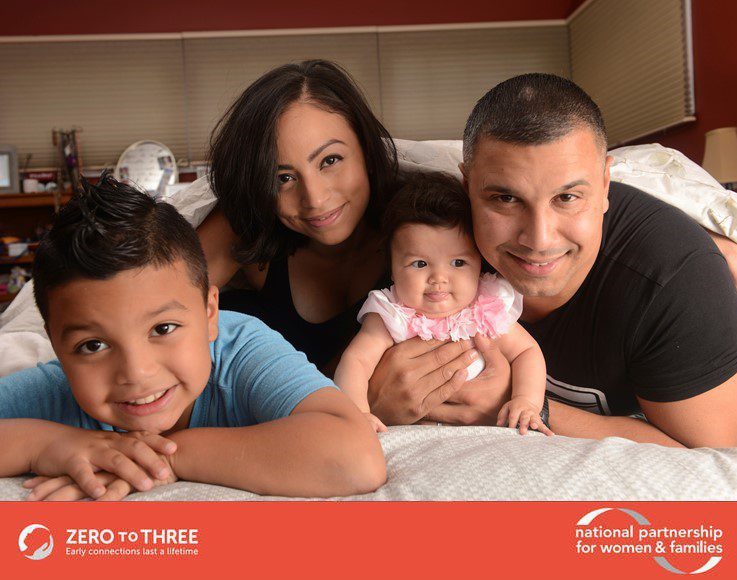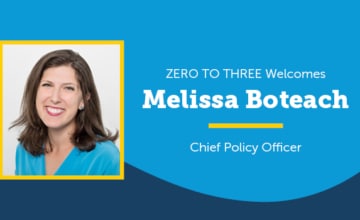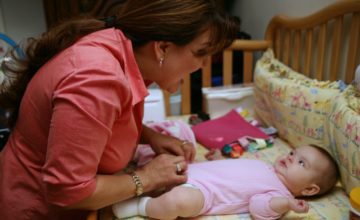We need public policies that promote time for parents and caregivers to care for and bond with their infants and toddlers, without jeopardizing the ability to pay for basic necessities.
In the first months and years of life, young children discover the world through experiences with their parents and other caregivers. A young child’s early relationships, especially with parents, shape the architecture of the developing brain. These relationships require care, consistency, and, above all, time.
Enacting public policies that provide parents with paid leave from work to care for their young children is critical to the healthy development of children and families. Because early brain connections form the foundation for all learning and relationships that follow, parents and caregivers are on the front line of preparing our future workers, innovators and citizens. Yet too many working parents and caregivers are forced to choose between caring for a new child and their economic security. Now is the time for policymakers to secure the best beginnings for children and the best future for our country by supporting a national paid family and medical leave program.
The Need: Public policies that promote time for parents and caregivers to care for and bond with very young children, without jeopardizing the ability to pay for basic necessities
Relationships with parents and other caregivers are critical to a baby’s early development.
- For babies, every minute and every interaction is a lesson in how the world works, how individuals relate to one another, and how they are valued. Caring, consistent relationships experienced by young children can mitigate the impact of stress and help develop the foundations of a child’s ability to learn, to form positive relationships, and to exercise self-control.
- It takes several months of focused attention to become a responsive caregiver to a young child, establishing a pattern that will influence the child’s long-term cognitive, social, and emotional development.
- The capacity to recognize a caregiver’s voice, smell, and face develops around three months of age. Paid time to care gives parents and babies important time to foster these connections.
- Parents and caregivers may also need time with a new baby to identify and intervene in a variety of developmental difficulties. This time is especially important for caregivers of infants who are considered at high risk, such as babies born preterm or at low birth weights and those who have illnesses or birth defects.
- Studies of two-parent, opposite-sex households show a number of positive outcomes when fathers take leave. Fathers who take two or more weeks off after the birth of a child are more involved in that child’s direct care nine months after birth than fathers who take no leave. Involved fathers also promote children’s educational attainment and emotional stability. And, a father’s involvement in a newborn’s care in the first six months can mean both mother and baby sleep better.
Because the United States lacks a national paid leave policy, economic necessity forces many new parents to go back to work and forgo precious bonding time with their children.
- Just 17 percent of all working people in the United States have access to paid family leave through their employers, and lower-income workers are even less likely to have access.
- Most employed women do not have access to paid maternity leave. About one-third of private sector workers (35 percent) are employed at worksites that offer paid maternity leave to all or most female employees, and only about one-fifth (22 percent) are employed at worksites that offer paid maternity leave to all female employees.
- In the private sector, even fewer worksites offer paid leave to most or all male employees,11 and men also face stigma and gender norms that discourage equal leave-taking. Research indicates that three out of four fathers in professional jobs took one week or less of leave after the birth of their most recent child, and nearly 60 percent of low-income fathers reported taking zero weeks of paid leave.
Too often, out of economic necessity, new parents are forced to go back to work and forego precious bonding time with their children.
- Most employed women do not have access to paid maternity leave. About one third of private sector workers (35%) are employed at worksites that offer paid maternity leave to all or most female employees, and only about one fifth (22%) are employed at worksites that offer paid maternity leave to all female employees.
- Most employed men do not have access to paid paternity leave. Of private sector workers, 11% are employed at worksites that offer paid leave to most male employees, and 9% are at worksites that offer paid leave to all male employees.
- Access to fully paid leave during the period of maternity-related disability at larger companies (those with 50 or more employees) is decreasing. Among employers voluntarily offering paid leave for new mothers, just 9% provided fully paid leave in 2014, a decline from 16% in 2008.
The solution: A national paid family and medical leave program
A national paid family and medical leave insurance program would support working people, their families, and businesses. A strong federal paid leave policy must include certain core principles:
- Inclusive of all working people, no matter where they live or the nature of their job;
- Comprehensive coverage of personal medical and family caregiving needs as reflected in the Family and Medical Leave Act (FMLA);
- Inclusive definition of “family”;
- Meaningful duration of leave – at least 12 weeks – and a benefit level that makes taking leave financially possible for everyone;
- Sustainable funding that is affordable for workers, employers and the government without harming other essential programs;
- Secure from adverse employment consequences for workers who need to take leave.
The benefits of paid leave for babies, their families, and the nation
A period of paid leave after the birth of a child contributes to the healthy development of infants and toddlers.
- Paid leave is strongly associated with reduced infant and post-neonatal mortality rates. Researchers conservatively estimate that providing 12 weeks of job-protected paid leave in the United States would result in nearly 600 fewer infant and post-neonatal deaths per year.
- Time at home with newborns, infants and toddlers gives parents the time they need to breastfeed, attend well-child medical visits, and ensure that their children receive all necessary immunizations,16 and may have long-term benefits for children’s health.
- California’s statewide paid family leave program, in effect since 2004, is associated with improved health outcomes for children in early elementary school, including reduced issues with maintaining a healthy weight, ADHD and hearing-related problems, particularly for less-advantaged children, likely due to reduced prenatal stress, increased breastfeeding and increased parental care during infancy.
- Studies show that paid leave yields higher rates and longer periods of breastfeeding, which reduces the rates of childhood infections.19 Paid family leave programs in California and New Jersey (in effect since 2009), where mothers take an average of 12 weeks of paid personal medical leave and family leave combined, increased the likelihood of exclusive breastfeeding at six months, the duration recommended by the American Academy of Pediatrics. In low-income families in New Jersey, new mothers who use the state paid leave program breastfeed, on average, one month longer than those who do not use the program.
- Time for parents to provide care facilitates the early detection of potential developmental delays at a time when problems can be most effectively addressed and interventions identified to minimize them.
Paid leave – at a child’s birth or adoption and as they grow – improves outcomes for the entire family, including parents and caregivers.
- Paid leave has health benefits for new mothers. Each week of paid leave up to 12 weeks reduces the odds of a new mother experiencing symptoms of postpartum depression. New Jersey’s paid leave program was strongly associated with improvements in new mothers’ physical health.
- Parents who use California’s paid leave program report that leave has a positive effect on their ability to care for their new children and arrange child care. And in Rhode Island, which implemented a paid leave program in 2014, parents who use the state program are much more likely to report higher satisfaction with their ability to care for their new children and arrange child care, better health and lower general stress, compared to parents who do not use the program.
- Preliminary research in California suggests that paid leave may also help prevent child maltreatment, perhaps by reducing risk factors such as parental stress and depression.
- Paid leave for a new child’s birth or adoption is essential, but parents also need paid family and medical leave when other situations require family caregiving. For example, the rates of childhood cancer have been increasing over the past 20 years. Almost half of all pediatric cancer occurs during early childhood, with the peak incidence of invasive childhood cancer occurring during infancy.
- Families who care for a child with cancer incur considerable costs due to travel, reduction or loss of parental employment, out-of-pocket expenses, and inability to draw on assistance programs to supplement or replace lost income. Paid family and medical leave would help to alleviate the financial burden and eliminate the fear of retaliation when returning to work after caring for a chronically ill child.
Paid leave policies can benefit employers, taxpayers and the economy, now and in the future.
- When parents can attend to a child’s early medical needs, infant mortality and the occurrence and length of childhood illnesses are reduced, which in turn lowers private and public health expenditures.
- Paid leave can give parents and other caregivers time to search for quality child care that meets the unique needs of their families, thereby facilitating greater productivity when they return to their jobs after leave.
- Positive, consistent relationships during a child’s early years yield confident individuals who are better equipped for success in school and in life, paving the way for a higher quality workforce and strong economic growth.
Reviewed June 2019
For a list of citations, download the full PDF.





